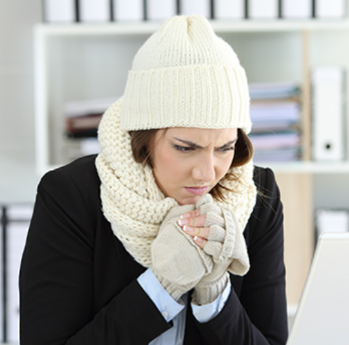News
Are You Sitting Comfortably? - 9 July 2019
Office Temperature Matters
No one is ever happy with the temperature in the workplace. There's the guy who's still in a t-shirt with frost on the windows and complaining it's hot. Then there's the woman in three jumpers and a coat when the heating is on full, saying it's 'freezing'.
But all joking aside, setting the right temperature in an office is vital – both to productivity and staff well-being. It's not simply about staff feeling a little uncomfortable in the cold or the heat, it can genuinely have serious physical and mental effects on their work.
Optimum Office Temperature
The jury is out on an exact optimum temperature for an office. But according to a study from 2006 by the Helsinki University of Technology and the Lawrence Berkeley National Laboratory, staff performance can increase if the room is a temperature up to 21 or 22⁰C. Highest productivity is delivered with a temperature of 22⁰C.
Of course, in practice, it's almost impossible to please everyone.
The Gender, Age & Fitness Divide
You may have noticed that many of the tension over office temperature is split between male and female, who simply can't agree. There is a very solid scientific reason for this.
Male and females have a different body chemistry. Women have a lower metabolic rate and tend to have more body fat, making them more susceptible to the cold than men. In summer, when the air conditioning is on full blast all day, they are more likely to feel the chill.
Conversely, men use up more energy than women, so that extra heat is more likely to cause them discomfort.
Interestingly, despite the relaxation of office dress codes, businesses may still require men to wear long-sleeved shirts, suits and jackets (especially where client facing meetings are prevalent). Whereas the options for women are naturally more flexible, allowing for skirts or dresses on warm days.
This temperature battle reached new heights when a study in 2015 found that most offices set their thermostats using a "male-centric" "thermal comfort model", leading to calls of sexism. Widely reported at the time, Cynthia Nixon, Governor or New York, called the temperatures favoured by men in offices "notoriously sexist".
But it's not just gender that needs to be considered. People's body mass index (BMI) also affects how they react to different temperatures. Those with a higher BMI will feel warmer more quickly, while those with lower than average BMI will get cold more easily.
Age is also a factor. Older people, especially over 55, tend to be more easily affected by the cold. So, if you have an older workforce, they might benefit from a slightly hotter office space.
Regardless it does fall on business owners to ensure the comfort of all staff to the best of their abilities.
How Does Office Temperature Affect Staff?
Everyone wants to be comfortable when they work, but the changes in temperature do have much more profound effects than a little discomfort. Even considering the above information, it has been found that as temperatures rise, productivity declines.
In really high temperatures concentration wanes and people become lethargic as the body works overtime to combat the heat and keep cool. The same is in much cooler temperatures as the body fights the cold.
This illustrates how crucial it is to find a balance.
What Other Factors Can Affect the Perception of Office Temperature?
It's not just our body composition that can create our impression of temperature, there are environmental, and other factors, that can make staff run hot or cold.
How the building is designed will make a huge difference. High ceilings will create poor air flow meaning that heaters and air conditioners will have to work harder, and many large windows will bring more sunlight into the office creating an impression of warmth.
Airflow can affect the humidity in the office. If the air is overly humid, people will sweat more, making them more exhausted and less able to work. A humidity level of 40% is considered optimum for comfort.
Low humidity is also a problem making the air feel colder than it is and leading to dry skin, throats and noses. This will also make staff feel uncomfortable.
Knowing the building can make all the difference when you're trying to get the temperature just right.
What Can We & Our Staff Do to Create a More Comfortable Environment?
Other than setting the thermostat to the best compromise temperature for everyone in the office there are other things you and your staff can do.
Lay the office seating plan out to optimise the temperature for certain members of staff. Put those who feel the cold the most, closest to heat sources and those who complain about it being too hot where there is a draft, or it is cooler.
Set an office dress code that allows people to dress comfortably for the time of year and the changes in temperature, don't insist on full business suits in the height of summer. Your staff might look the part but will be unable to operate as they melt!
It's also important to make sure your staff are well-hydrated. Renting a water cooler or topping up bottled water in the office fridge might make your staff feel loved but it could genuinely increase productivity by naturally regulating their body heat. Additionally, physical activity would help increase energy levels and keep your staff alert.
It is never going to be possible to please everybody when it comes to office temperature but making sure everyone is as comfortable as possible is essential for a successful business. Hot or cold, getting it wrong can harm productivity.
That's no good for anyone.

